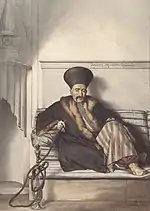Kodjabashis
The kodjabashis (Greek: κοτζαμπάσηδες, romanized: kotzabasides; singular κοτζάμπασης, kotzabasis; Serbo-Croatian: kodžobaša, kodžabaša; from Turkish: kocabaṣı, lit. 'office holder' from Turkish: koca, lit. 'big' and Turkish: baṣ, lit. 'head')[1] were local Christian notables in parts of the Ottoman Balkans, most often referring to Ottoman Greece[2][3] and especially the Peloponnese. They were also known in Greek as proestoi or prokritoi (προεστοί/πρόκριτοι, "primates") or demogerontes (δημογέροντες, "elders of the people"). In some places they were elected (such in the islands for example), but, especially in the Peloponnese, they soon became a hereditary oligarchy, who exercised considerable influence and held posts in the Ottoman administration.[2]

The title was also present in Ottoman Serbia and Bosnia,[4][5] where it was known as starešina ("elder, chief") instead of the official Turkish name.[6] The terms chorbaji (from Turkish çorbacı) and knez (a Slavic title) were also used for this type of primates, in Bulgaria and Serbia respectively.[7]
The equivalent of the kodjabashis in Orthodox villages was the mukhtar in Muslim villages, while mixed villages had both.[8]
During the Greek War of Independence, the antagonism between the Peloponnesian kodjabashis, who sought to retain their previous preponderance and power, and the military leaders drawn from the klephts, was one of the main driving forces behind the outbreak of the Greek civil wars of 1824–1825, in which the "aristocratic" faction comprising the kodjabashis, the wealthy shipowners of Hydra and the Phanariotes, prevailed.[9]
See also
References
- Speake, G. (2021). Encyclopedia of Greece and the Hellenic Tradition. Taylor & Francis. p. 896. ISBN 978-1-135-94206-9. Retrieved 2023-04-09.
- Stavrianos 2000, p. 273.
- Zakythenos 1976.
- Hannes Grandits (2008). Herrschaft und Loyalität in der spätosmanischen Gesellschaft: das Beispiel der multikonfessionellen Herzegowina. Böhlau Verlag Wien. pp. 564–. ISBN 978-3-205-77802-8.
- Jahrbücher für Geschichte und Kultur Südosteuropas: JGKS. Vol. 8–10. Slavica Verlag. 2006. p. 92.
- Milenko S. Filipović (1982). Among the people, native Yugoslav ethnography: selected writing of Milenko S. Filipović. Michigan Slavic Publications, Dept. of Slavic Languages and Literatures. p. 261. ISBN 9780930042479.
- Stavrianos 2000, p. 224.
- Simpozijum Seoski dani Sretena Vukosavljevića: 14., 15. i 16. jun 1974. godine. Opštinskȧ zajednica obrazovanja. 1974. p. 98.
- Clogg, Richard (2002). A Concise History of Greece (Revised ed.). Cambridge University Press. pp. 35ff. ISBN 0521004799.
Sources
- Stavrianos, Leften Stavros (2000) [1958]. The Balkans Since 1453. C. Hurst & Co. Publishers. p. 273. ISBN 1850655510.
- Zakythenos, Dionysios A. (1976). The Making of Modern Greece: From Byzantium to Independence. Rowman and Littlefield. ISBN 978-0-87471-796-9.